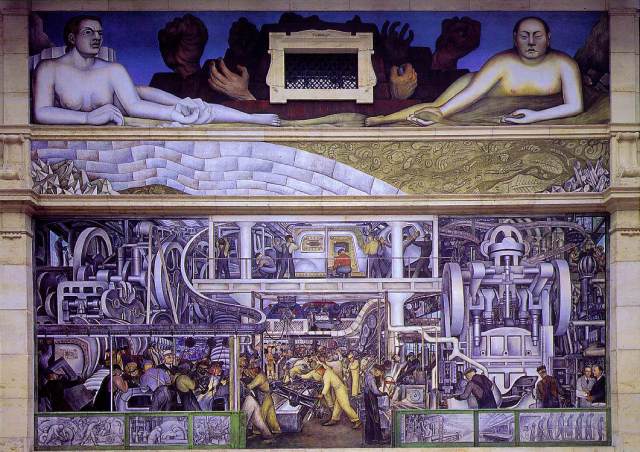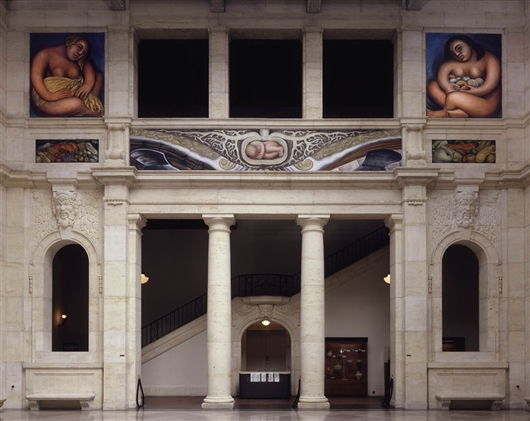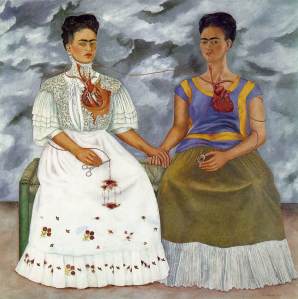There is no greater symbol of the rise of industry in the early twentieth century than Mr. Henry Ford, originator of mass production and the assembly line. This innovation made it possible to produce automobiles (and everything else) much more rapidly than had ever previously been achieved. The automobile industry created in the city of Detroit a model for other industrial centers to follow, a prototype of what grandeur a bustling industry can bring to a town. And what better way to celebrate this greatness than with a grand work of art to be displayed in the initial courtyard at the entrance of the Detroit Institute of Arts (DIA).

Edsel Ford, son of Henry, and William Valentiner, then director of the DIA, teamed up to commission such a piece of work (Gonyea, 2009). The piece was to be a mural of grand proportions, taking up two full walls in the garden court at the DIA. They chose one of the leading muralists of the day to paint the work: Diego Rivera, a renowned Mexican painter. Rivera came to Detroit in 1932 and spent a month observing workers at a Ford Plant before beginning the mural. He was impressed with the Fords and the auto industry as a whole in Detroit and, in an effort to fully portray the spirit of industry, asked permission to paint a total of twenty-seven frescoes covering all four walls of the court. This request was accepted and, over the next nine months, Rivera created Detroit Industry, a gigantic tribute to the birth and fertility of industry, completing it in March, 1933 (Gonyea, 2009).

The four walls of the painted courtyard depict many varied aspects of industry. The two largest murals, found on the lower north and south walls, are detailed scenes of life within an automobile factory. Every step, from the forging of the steel to the actual assembly of the car is shown; the workers are men from all races, working side by side as members of a giant team. The theme is clearly man versus machine, or ideally, the union of man and machine, as both were necessary for the process. There is even an accountant included, so as not to miss any aspect of the business. The West wall includes images of Ford and Valentiner, the commissioners of the mural (Gonyea, 2009). The east walls frescoes are of fertile woman bearing local fruits and vegetables. There is also a fetus curled up in a seed beneath the ground: The connection of humans to the earth. There are airplanes, both commercial and war-going, and scenes of poison gas creation and vaccinations. Rivera wanted to include all aspects of industry, both positive and negative, so as to show the reality of what was created by technology. The result is a very intricate and inclusive series of frescoes, and Rivera’s self-proclaimed best work (Freudenheim, 2010).

There were many dissentions to this judgment of greatness, however. Many different people were outraged by this work for varying reasons. Some people found it outrageous that Rivera had been selected to paint this work, despite his incredible talent and the fantastic outcome. Rivera was a Mexican, and America was in the middle of a depression. Could not an American painter have been commissioned, keeping the job local? Others were infuriated because Rivera was a proclaimed communist. Why should a communist be chosen to paint a scene of pure capitalist industry?

Some complained of the nature of the work itself. Rivera included figures representing the white man, the black man, the red man, and the yellow man, believing that all must work together to keep something as great as industry together, some disagreed. Others of a more religious stance were appalled at his inclusion of a nativity-like scene, with the child receiving a vaccination. A front page editorial in the Detroit News on March 18, 1933 sums up this anger: “”Rivera’s whole work and conception is un-American … and foolishly vulgar. It bears no relation to the soul of the community, to the room, to the building or to the general purpose of Detroit’s Institute of Arts (Aguilar, 2011).” The editorial was unsigned.
Regardless of all this controversy, Ford loved the work, as did the general public. The work supremely displayed the real life of those in industry and was an exaltation of the spirit of Detroit, a grand city at the time. The work remains where it was painted and is hopefully, today, still a beacon of hope to the now-dying city of Detroit. Today, the scenes pictured in Rivera’s mural are rare in Detroit; most of the auto industry factories have relocated out of the country, leaving rusted assembly lines and huge abandoned buildings. The population is rapidly falling and many of those remaining are jobless, with no hope in sight. Those with the means have left the city, looking for better opportunities elsewhere.
I grew up with this fantastic mural, visiting it at least once every year of my early life, whether on a school field trip or on my own. I have always enjoyed the rich detail and giant scale of the mural, however, this is the first time I have ever researched it in any depth. It always served as the gateway to the rest of the artworks at the DIA and, while I usually paused to glance around the courtyard at this massive mural, I rarely stayed for long. I now know more of its history and meaning (and controversy) than ever before. I cannot wait to return to Detroit for a visit so I may look upon Detroit Industry with new eyes. This is truly what I love about art, that something so familiar can suddenly look so new through enlightenment.
And as for Detroit, I admit it may not get better if people continue to leave (I myself am included in this group), but it is works like this, that remind one of the glory Detroit once had, that may one day revive it. Some say the soul of Detroit has gone, but as long as Detroit Industry remains, its soul can never be far away.
Sources:
Aguilar, Louis. 2011. Detroit was Muse to Legendary Artists Diego Rivera and Frida Kahlo. Retrieved from http://www.detnews.com
Freudenheim, Tom L. 2010. When the Motor City was a Symbol of Strength. Retrieved from http://online.wsj.com
Gonyea, Don. 2009. Detroit Industry: The Murals of Diego Rivera. Retrieved from http://www.npr.org


























